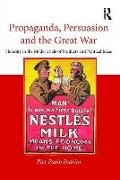Read more
List of contents
Preface
Introduction
1 Propaganda and Persuasion
2 Persuading for the Great War
3 The Organization of the Persuasive Apparatus
4 Attracting Attention
4.1 Children as decoy
4.2 Beauty as decoy
5 Repeating the Message
6 The Power of Questions
7 The Persuasion of the Source
7.1 The authority of source
7.2 The authority of quotations
8 Unity is Strength
8.1 Silencing the critics
8.2 Origins unite
8.3 The call of the banner
8.4 Other patriotic symbols of unity
9 Target 1: The Home Front
9.1 Out of duty and solidarity
9.2 To educate, inform
9.3 Persuading to invest
9.4 Children and the principle of familiarity
9.5 Women as weapons of persuasion
9.6 Reciprocity. I am fighting for you!
9.6.1 Reciprocity and the strategy of shame
9.6.2 The veterans
9.6.3 The intellectuals
9.6.4 The Afro-Americans
9.6.5 The immigrants
10 Target 2: Men to Enlist
10.1 Follow the example
10.1.1 Follow the example of your ancestors
10.1.2 Follow the example of your countrymen
10.1.3 Follow the example of sportsmen
10.1.4 Follow the example of your friends
10.2 The propaganda of fear
10.2.1 Denouncing the crimes of the enemy
10.2.2 Demonizing the enemy
10.3 The principle of scarcity. Illustrating threats
10.3.1 Democracy
10.3.2 Liberty
10.3.3 Honour and justice
10.4 The family
Conclusion
List of Images
Index
About the author
Pier Paolo Pedrini teaches Techniques of Persuasion for the Masters Program in Public Management and Policy at the University of Italian Switzerland, Psychology of Communication at the Institute of Continuing Education and at other advanced schools. A researcher at the Ecole Nationale de l’Administration Publique (Université du Québec en Outaouais, Gatineau), he is also an advertising agent and a consultant for marketing and advertising.
Summary
How to persuade citizens to enlist? How to convince them to fight in a war which was, for many, distant in terms of kilometres as well as interest? Modern persuasion techniques, both political and commercial, were used to motivate enlistment and financial support to build a "factory of consensus". The propagandists manipulated the public, guiding their thoughts and actions according to the wishes of those in power and were therefore the forerunners of spin doctors and marketing and advertising professionals. Their posters caught the attention of members of the public with images of children and beautiful women, involving them, nourishing their inner needs for well-being and social prestige, motivating them by showing them testimonials in amusing and adventurous situations, and inspiring their way of perceiving the enemy and the war itself, whose objective was to "make the world safe for democracy".
In the discourse of this strategy we find storytelling, humour, satire and fear, but also the language of gestures, recognized as important for the completeness of messages. Were the propagandists "hidden persuaders" who knew the characteristics of the human mind? We do not know for certain. However, their posters have a personal and consistent motivation which this book intends to demonstrate.

